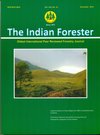Impact of Input Use on Biomass Attributes and Carbon Mitigation in Agroforestry Systems of Indian Himalaya
DOI:
https://doi.org/10.36808/if/2016/v142i12/84943Keywords:
Effect, Carbon, Vegetable, Cereal, Biomass.Abstract
In the present study, the authors investigated the effect of input use for biomass attributes and carbon mitigation in agroforestry. The study was carried out in Kwalkhad watershed Himachal Pradesh, India and falls in the transitional zone between the Shiwalik or outer Himalayas and middle Himalayas. The watershed is covered by the survey of India topographical map 53F/I (1:50,000). The annual crop sequences and the functional components used under each sequence were taken as the criterion to classify the different system units as: low input, medium input or high input use system units. Annual crop sequences cereals + pulses + vegetables fallow (CPV-F), cereals + pulses fallow (CP-F) were taken as low input use; cereals + pulses + vegetables cereals + vegetables (CPV-CV), cereals + pulses - cereals + vegetables (CP-CV) as medium input use; and cereals + vegetables cereals + vegetables (CV-CV), cereals + vegetables - vegetables (CV-V), vegetables - vegetables (V-V) were taken as high input use sequences. In all the systems maximum accumulated as well as retained biomass was recorded under the high input use systems with CV-CV annual crop sequence. The values ranged from 229.78 to 459.81 q/ha and 104.14 to 179.10 q/ha, respectively for accumulated and retained biomass. However, for biomass removal no particular relationship was obtained with input levels. The carbon mitigation varied across different system units and was of the order: AHS (7.15 Mg ha-1) > ASH (7.03 Mg ha-1) > AS (4.69 Mg ha-1) > AH (3.55 Mg ha-1). Input use levels affected biomass attributes and hence, carbon sequestration and emission of different agroforestry systems also varied.References
Bitterlich W. (1984). The relaskop idea slough: Commonwealth Agricultural Bureau. Farnham Royal, England.
Cairns M.A. and Meganck R.A. (1994). Carbon sequestration, biological diversity and sustainable development: integrated forest management. Environmental Management, 18: 13-22
Goswami S., Verma K. S. and Kaushal R. (2014). Biomass and carbon sequestration in different agroforestry systems of a Western Himalayan Watershed. Biological Agriculture and Horticulture http://dx.doi.org/10.1080 /01448765.2013.855990
Graham R.L., Wright L.L. and Turhollow A.F. (1992). The potential for short rotation woody crops to reduce US CO2 emissions. Climate Change, 22:223-238
IPCC (1996). Revised 1996 IPCC guidelines for National Greenhouse Gas Inventories. Cambridge University Press, Cambridge, U.K.
Jana B.K., Biswas S., Majumder M., Roy P.K. and Mazumdar A. (2009). Carbon sequestration rate and above ground biomass carbon potential of four young species. J Ecol Nat Environ., 1:15-24
Kanime N., Kaushal R., Tewari S.K., Raverkar K.P., Chaturvedi S. and Chaturvedi O.P. (2013). Biomass production and carbon sequestration in different tree based systems of Central Himalayan Tarai region. For Trees Livilihoods, 22:38-50
Komatsuzaki M. and Ohta H. (2007). Soil management practices for sustainable agro-ecosystems. Sustainability Science, 2 (1): 103-120.
Nabuurs G.J., Masera O., Andrasko K., Benitez-Ponce P., Boer R., Dutschke M., Elsiddig E., Ford-Robertson J., Frumhoff P., Karjalainen T., Krankina O., Kurz W.A., Matsumoto M., Oyhantcabal W., Ravindranath N.H., Sanz Sanchez M. J. and Zhang X. (2007). Forestry. In Climate Change 2007: Mitigation. Contribution of Working Group III to the Fourth Assessment Report of the Intergovernmental Panel on Climate Change (ed. Metz, B., Davidson, O. R., Bosch, P. R., Dave, R., Meyer, L. A.), Cambridge University Press, Cambridge, United Kingdom and New York, NY, USA, 2007.
Nair P.K.R., Nair V.D., Kumar B.M. and Haile S.G. (2009) Soil carbon sequestration in tropical agroforestry systems: A feasibility appraisal. Environment Science and Policy, 12: 1099-1111
Nair P.K.R., Nair V.D., Kumar B.M. and Showalter J.M. (2010) Carbon sequestration in agroforestry systems. Advances in Agronomy, 108: 237-307
Niu X. and Duiker S.W. (2006). Carbon sequestration potential by afforestation of marginal agricultural land in the Midwestern US. For. Ecol. Manag., 223:415–427.
NRCAF (2007). Perspective Plan Vision 2025 National Research Centre for Agroforestry, Jhansi, Uttar Pradesh.
Pressler M. (1865). Das Gesetz der Stambildung Leipzig 153 p.
Rajput B.S., Bhardwaj D.R. and Pala N.A. (2015). Carbon dioxide Mitigation potential and carbon density of different land use systems along an altitudinal gradient in north-western Himalayas Agroforest Syst., 89:525 DOI 10.1007/s10457-015-9788-8
Rurak G.A., Schoeneberger M.M. and Nair P.K.R. (2003). Agroforestry: Helping to achieve sustainable forest management. Intersectional experts meeting on the role of planted forest in sustainable forest management, 24-30 March 2003, New Zealand. www.maf.govt.nz.
Verchot Louis, Meine Van Noordwijk V, Kandji Serigne, Tomich Tom, Ong Chin, Alain Albrecht, Mackensen Jens, Bantilan Cynthia, Anupama K.V and Palm Cheryl (2007). Climate change: linking adaptation and mitigation through agroforestry. Mitig Adapt Strat Glob Change DOI 10.1007/s11027-007-9105-6. Springer
Woomer P.L. (1999). Impact of cultivation of carbon fluxes in woody savannas of Southern Africa. Water, Air and Soil Pollution, 70(1-4): 403-412.
Downloads
Downloads
Published
How to Cite
Issue
Section
License
Unless otherwise stated, copyright or similar rights in all materials presented on the site, including graphical images, are owned by Indian Forester.





